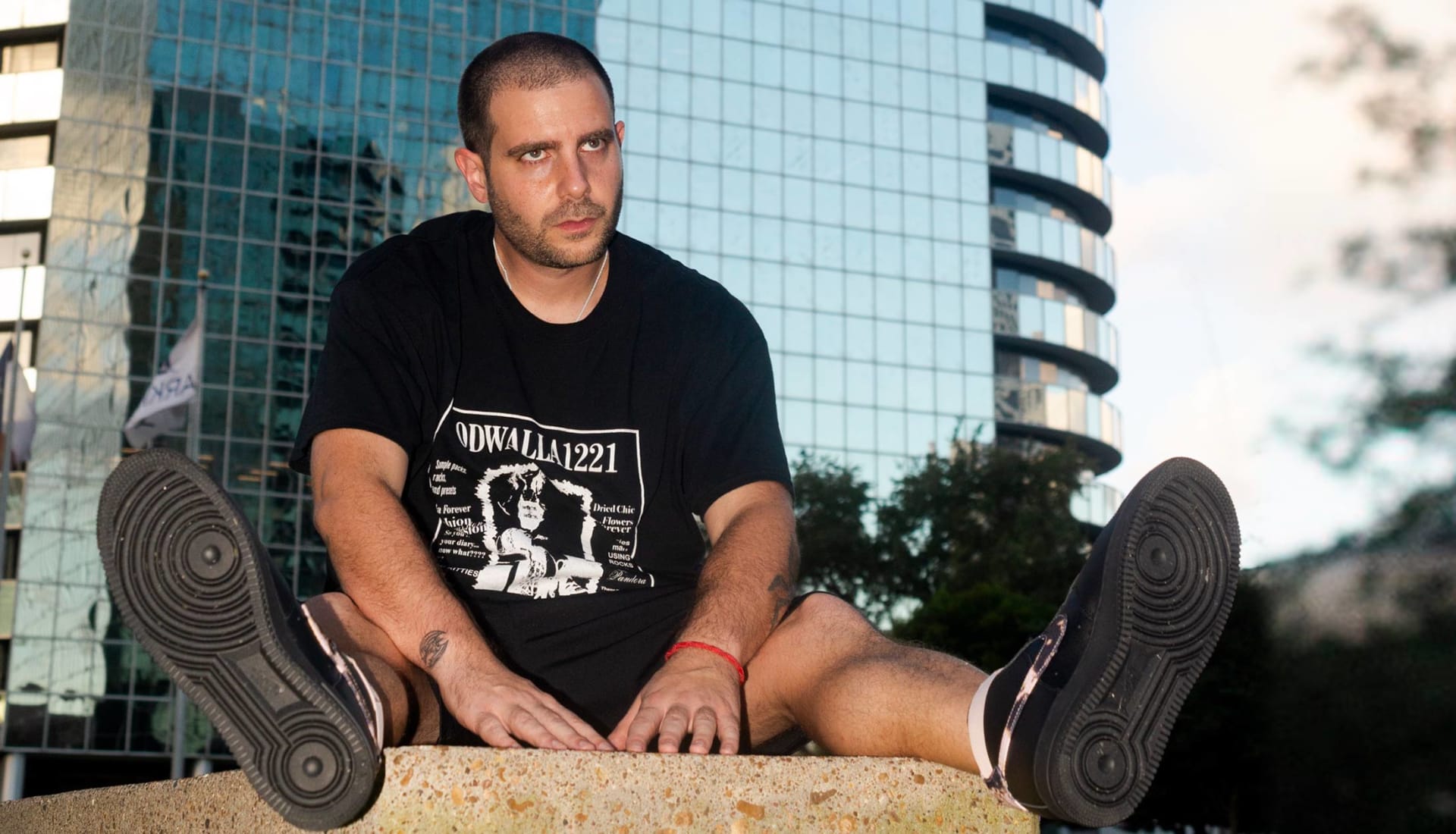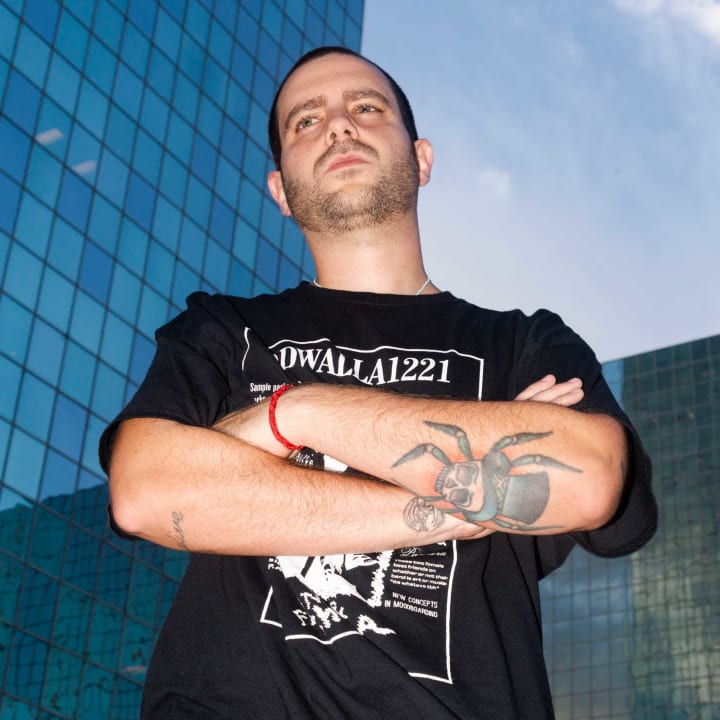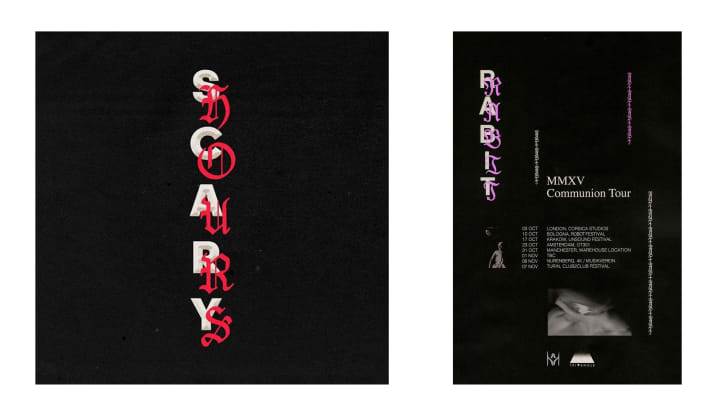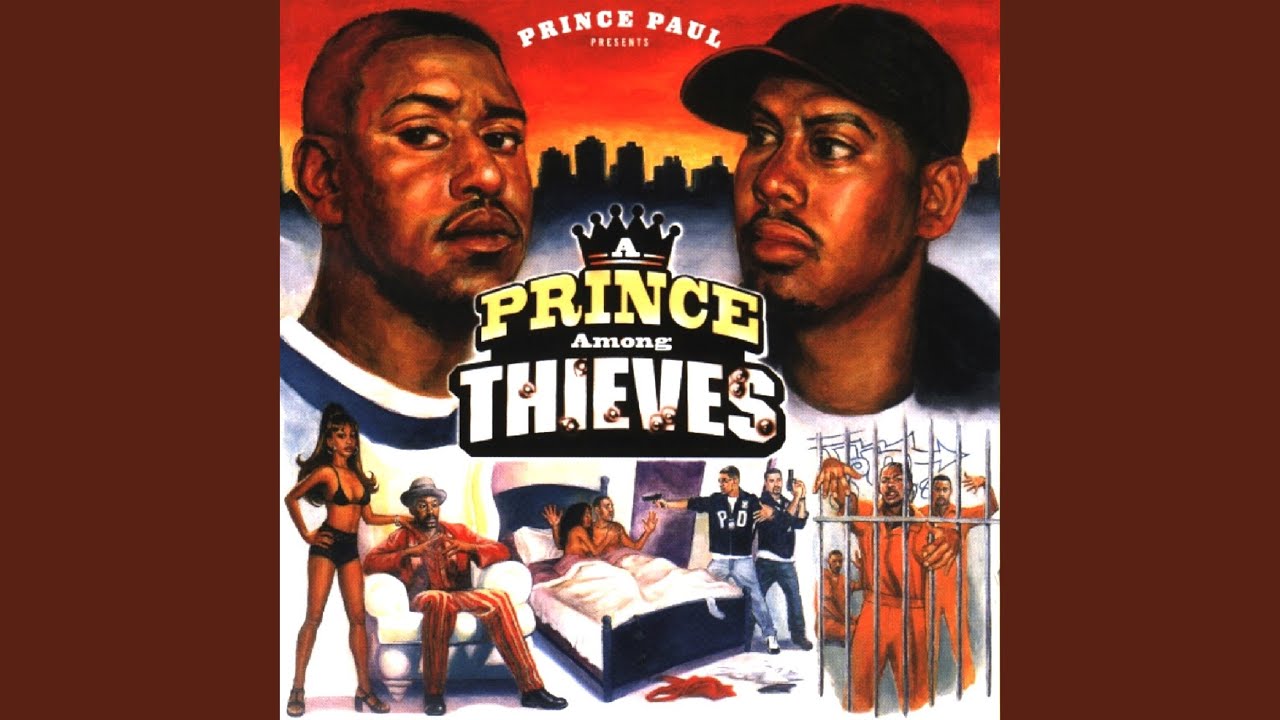
The Best Music Is Ratchet: Rabit On Rap, Intellectual Property And The Texas Underground
You may not know much about Houston, Texas, and that might be by design. Since the ’90s, the city’s relentlessly inventive scene has been churning out quality music that’s been routinely (and often criminally) overlooked. But from the warehouses of what is essentially a swamp on the edge of the Gulf of Mexico, there’s a thriving club scene that’s bubbling into the mainstream, and thats thanks largely to the output of internet-based label Halcyon Veil and its founder, Rabit.
Last month marked the release of Rabit’s latest album, Life After Death. Like much of his work—and the work of the other artists on his label, like Why Be and 700 Bliss—it draws inspiration from a dense array of sources that includes such disparate touchstones as DJ Screw, Enigma and Hiroshi Yoshimura. At the center of Rabit’s work, though, is one influence that sneaks its way into nearly everything he produces, firmly rooting him in Houston’s legacy: southern rap. This is an aesthetic and conceptual influence that also manifested in the release of two mixtapes this year, the borderline ’90s trance-influenced Cry Alone Die Alone and the more Screw-indebted Bricks In A Drought.
Later this month, on November 23, he will release Toe In The Bardo Pond EP, which manipulates and reinterprets the sounds on Life After Death. Before that, though, we gave him a call to discuss his work and to understand the challenges facing artists operating within the contemporary underground.
Get up to speed and get some context with this playlist of southern rap classics compiled by Rabit himself.
This summer, you dropped two mixtapes of your take on chopped-and-screwed music. For a lot of people, that probably seemed like a departure. What was your intention there?
Creatively, releasing those mixtapes was about doing something more direct while also pulling together the genres I’m into. People who don’t get to see me do a certain kind of DJ set might not know that I play this kind of music, so I wanted to release something that they could get.
I also tried to keep it urgent. It was really important to me to put the project out before I had a chance to filter it too much.
The DIY aspect of it seems closer to a rap mixtape mentality than an electronic album. Like putting out a tape of bootlegs…
In a way, it was like putting out a street album, like rappers do now. It allowed me to play with these boundaries of what an original song is—what’s remixed, what’s sampled—and this came from thinking more about DJ Screw.
Obviously, there was respect paid to him. It’s not like culturally he was ignored, but he’s ignored in the more academic experimental music canon. I started thinking more about how this guy was just allegedly “remixing” songs. It made me wonder about the boundary of when something crosses over and transforms into something else.
On the experimental music canon, I remember you saying that you don’t really feel like a part of that scene. What did you mean by that?
Recently, I was thinking about American music and what that means. The electronic music that’s seen as a benchmark has certain signifiers that are Eurocentric and also very white-centered. I chose to make these projects about the DJ Screw mixtapes because I think you have to celebrate work like his and put it on a pedestal as much as everything else.
As for being connected to any musical scene, I don’t know if I feel like I am. I grew up with grunge, and I feel like this new wave of music is the thing after grunge—something that represents a different part of culture, a different group of people, something that’s DIY. It’s kind of like how there used to be hardcore punk shows in everyone’s neighborhood. Now people have small club events. Before grunge, people sold rap mixtapes. Before that, they threw house and techno parties. These are all American things, and it’s important to remember how they started.
The DIY club scene in the US seems relatively fragmented though. What’s the network like city to city?
We all recognize when we meet someone else doing the same thing in a different city. When we see people like Ariel Zetina or Club Chai, we try to support those people and work together—not necessarily to make it bigger but to connect the dots. We also recognize that we’re doing something outside of the framework where the majority of things exist. I really want to find ways to make it possible for people to make their art and live from it.

The scene you’re in is still underground, but you’ve had moments of near mainstream success. What drives you back into the scene instead of into the spotlight?
I want do something different every time. It might be sabotage, but I feel like art is more interesting that way. That’s why I was excited that people were receptive to these mixtapes. And I’ve been tired of artists only using social media to communicate. Instead of tweeting something, I’d rather just communicate via actual work.
Let’s talk about your new album, Life After Death. What was the process behind its creation?
The tracks were all a lot longer—sometimes like 30 minutes long—but because I didn’t want to make a really unapproachable, purely experimental record, it was about trimming them down into short segments and different moods and putting them in one place, condensing them to two to three minutes.
There’s a lot of electronic music solely about getting into the nerdy aspects of writing music. While I do appreciate some of that music, I wouldn’t be interested in something just because it was hard to make. That’s not where music strikes me. And, honestly, I don’t really consider the stuff I release that difficult, even though some people think it is.
By loading the content from Bandcamp, you agree to Bandcamp's privacy policy.
Learn more
Was there a conceptual drive behind the album?
It’s conceptual, but it’s also kind of ambiguous. I like to experiment with super nerdy producer stuff—learning about process, getting new programs—but to me, where the actual art comes in is using it to say something. And I’m also slowly learning more and more about the album process. I like my music to reflect whatever I’m thinking about at the time, and I like to create an arc and combine these different moods. For this album, I cut the material down to the essential ideas, but I wasn’t interested in making them into songs. Our ears want to hear a verse and a hook, and we want things to naturally follow a pattern. But I’m happier honing in on the ideas to create a bigger story out of them.
The tracks definitely work outside of a traditional pop structure. Did you frame them with a different structure in mind?
I’ve been interested in classical music structures, where there’s one repeating theme that stops and changes or switches to another instrument. There will be a buildup with an orchestra, then a violin will play the theme by itself. I wanted to combine different structures on the same song without them totally coming together right away. The songs stop and change, and I like the juxtaposition of ideas that don’t immediately make sense.
The album feels less like a collection of songs than a movement through different spaces.
I edited the album to play more like an “audio book” with different sections and chapters. Something that I really like about rap albums is that they have skits. My music has become known as something so serious, but it’s also cool to put in extra skits that might be serious but also might not be. Interludes can add a flow or story to an album. In a weird way, on the most famous rap albums, the skits are remembered as much as the songs.
A lot of those albums were influential in the way they dispersed audio. It sounds super academic, but I was always into that. The Notorious B.I.G album Life After Death was this long, epic album, but it flows because of all the skits and interludes added. It’s like breaking into regularly scheduled programming with a story. Thinking about this made me want to add these narrating voices between the tracks. I’m curious how people will approach them, because the samples sound really preachy. It’s pretty funny in my opinion.
A lot of people overlook the connective tissue between tracks.
Sometimes those are the most memorable aspects of the production. When The Neptunes produced Slim Thug’s album, one of the singles featured this woman yelling over the entire track. She’s kind of talking shit to him over the chorus. Aspects like that are really memorable and can tell a bigger story. As I continue to make more music, I’m finding more ways to show what I’m influenced by. Not that that’s a goal, but you can’t help but be influenced by things.
At this point in culture, it seems like everyone’s trying to front like all of their ideas are theirs. That’s why I try to be open about what I’m into and what influenced me: visual art, films and books. No idea is original, and a good way to take things further is to be overt about what’s influencing you as an artist and to do something new with it.
I was basically a rap nerd. I spent years obsessively listening to rap music and learning everything about it. This is a way I get to put it to use: using rap ideas on an electronic album, even if it doesn’t really make sense.
It’s interesting the way culture generates. It starts with small pockets of people on Instagram giving out content for free, sharing their lives—what they’re wearing or listening to. But most people don’t understand that there are also greedy people who are going to take that.
We just had a situation with the Chemical Brothers. Der Kindestod, an artist on my label, made a track by chopping up this political sample that repeats the phrase “free yourself.” Then the Chemical Brothers put out a single called “Free Yourself”, and it was obvious they’d somehow found the sample, chopped it the exact same way and then removed everything political about it, leaving only the part that says, “free yourself, free me, free you, dance.”
I also had a tour poster from a year ago that Drake’s team completely re-did for his single “Scary Hours”. I posted it, then it was on all of the rap sites, and I had all of these journalists asking me for quotes. It was basically the most viral thing I’ve ever done. Also, my friend used to work for OVO. They once approached him to do a Drake and 21 Savage video. He made a treatment, then they didn’t hire him and had some other guy reverse engineer the entire video he’d created. He also put these pictures of scorpions in the treatment, saying that Drake should be using this imagery because he’s a Scorpio. Six months later, his album is called Scorpion. I deleted my post, and he can’t gain much from outing anybody. But I realized there’s a very thin line between these worlds.
Instagram is basically a grocery store for mainstream artists. The next time they come out, they looking like an amalgam of NON and PAN—it makes it weird to create when someone who works for a bigger artist could steal that idea and make a ton of money with it.

What’s it like to run a label in that climate?
I started realizing the difference between labels and collectives. Halcyon Veil is a business, sure. But I constantly post other people’s shit because I view it as a collective. I don’t need to release a record from someone to want to spread what they’re doing. Most labels are limiting and have kind of fallen off or become archaic because they don’t support other labels. And they only support artists they can make money on or virtue signal with. But Halcyon Veil is pretty organic overall. It grows by itself based on the strength of the music. For my friends and me, it’s all happening at a grassroots level. It’s a joint effort. We put our experiences into our music, and we don’t use a mood board when it’s time to make an album. But one step above us, everyone acts like all their ideas are original and they don’t need any help.
It can be challenging, though, because I’m in between worlds. I produced a song for Björk’s album, but I decided to release another album of experimental music. If I wanted to take advantage of everything—if it was all about me—I wouldn’t have done this.
And that’s the parallel with Coil. Now, they’re the hot band that everyone wants to reference. It’s funny, people don’t know that they weren’t cool when they came out. Like they were ratchet.
Is there anything outside of your own experiences that inspired the record?
I have these CDs: all of the Coil albums, then some UGK and Pimp C CDs. I keep them by my bedside, and they’re the only physical music I own. One time, I had this thought: What if all of the digital media got wiped out? What would I really want to own and be able to take with me? It’s like an apocalyptic version of a desert island disc. It made me think about what I was really into. The past year or two have been about refining the things that I’m influenced by and finding the main things that I that I care about, that I consider raw. There’s something about those albums that’s really compelling to me, and I think it’s the idea that as an artist, it’s not always going to be easy.
The industry didn’t support southern rap artists when UGK came out. Rapping about cars, girls and drugs was unorthodox. But they were rapping about it because that’s what was around them. And that’s what they liked. But the industry saw it as criminal. Sometimes people are perceived as the devil, but then, years later, they’ve influenced mass culture by the millions, and all the white kids want to be them.
And that’s the parallel with Coil. Now, they’re the hot band that everyone wants to reference. It’s funny, people don’t know that they weren’t cool when they came out. Like they were ratchet. They were doing fucked up performances. Some records did well, then they would drop some record everyone was confused by. Those connections made me think about how art that comes from certain people is dangerous at first. Like, “It’s this dangerous thing. It’s not high art. It’s bad. It’s ghetto.” But if you give it enough time…
This album feels heavy in a mature way, in relation to your past work.
I’ve said in the past that ambient music is kind of whack. That’s not to say I don’t like it, but it doesn’t tell my story or my friends’ stories. So this album was an accumulation of those influences but done in a more punk way—actually having a backbone and not making like a coffee table album. While I like ambient music and trip hop, when that music was at its peak, it was coffee table music or something that played at Urban Outfitters—in the background. It’s vanilla, and it’s left too open. This album is me updating that formula.
Part of my growth as an artist is making identifiable work and not being confused with the droves of other reductive work that’s out there. That’s why I’m proud of it, because I don’t think anyone else could have made it.
It’s got to be a good feeling.
It’s cool. It’s scary. It’s a little weird because I’m doing it by myself. I’m not saying I won’t change so something can be better or bigger, but I think for this album—something that’s making as big of a statement as it is—it had to keep its insular nature and not have someone else’s fingerprints on it.
Rabit’s new album, Life After Death, as well as his two mixtapes released this summer, Cry Alone Die Alone and Bricks In A Drought, are available now via his Bandcamp here. Toe In The Bardo Pond, his forthcoming EP, will be released via Halcyon Veil on November 23.
Published November 09, 2018.


